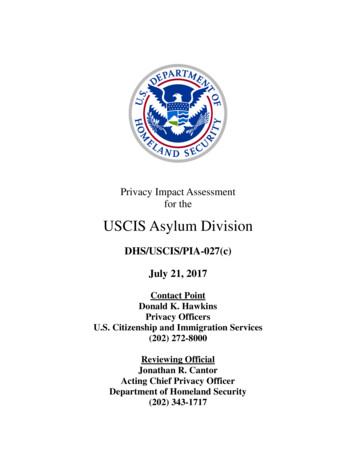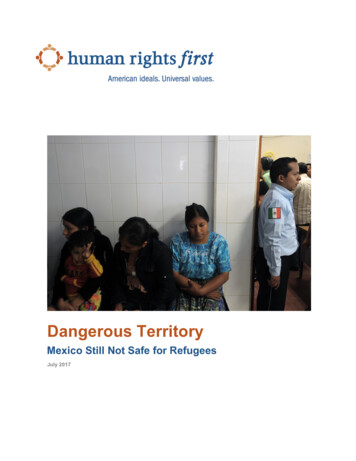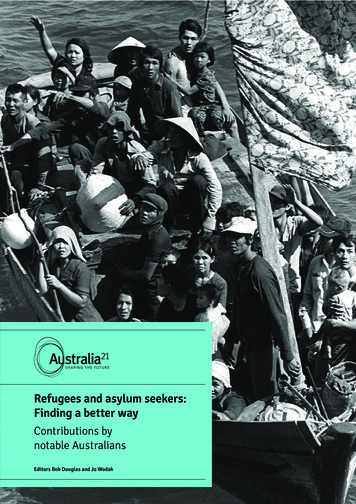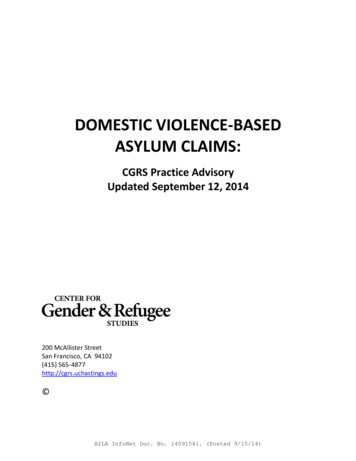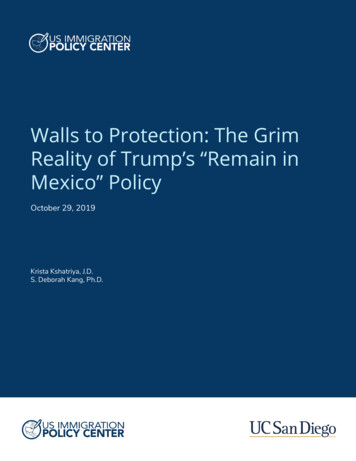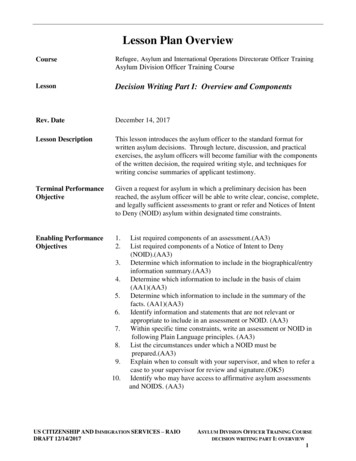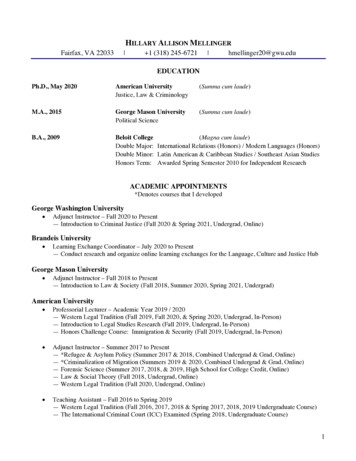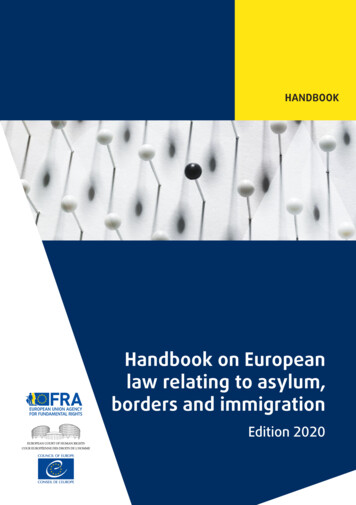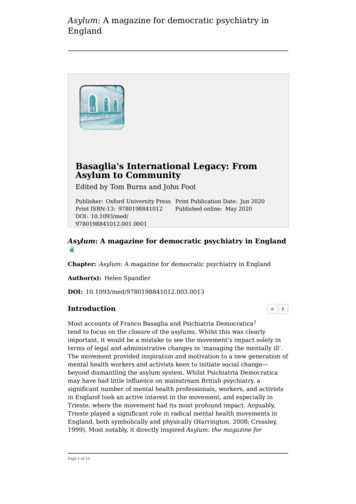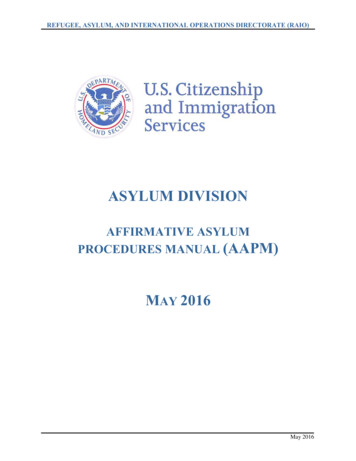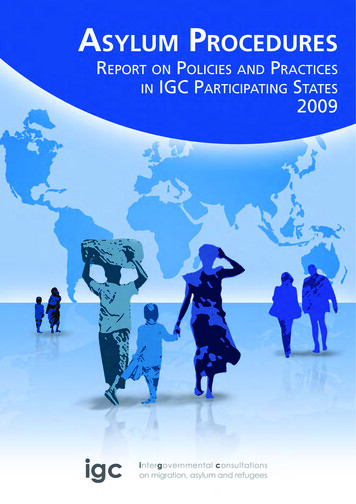
Transcription
Asylum ProceduresREPORT ON POLICIES AND PRACTICES IN IGC PARTICIPATING STATESMay 2009
The IGC is an informal, non-decision making forum for inter-governmental information exchange and policy debateon issues of relevance to the management of international migratory flows. The IGC brings together 17 ParticipatingStates, the United Nations High Commissioner for Refugees (UNHCR), the International Organization for Migration(IOM) and the European Commission. The IGC is supported by a small Secretariat located in Geneva, Switzerland.The Participating States are Australia, Belgium, Canada, Denmark, Finland, France, Germany, Greece, Ireland,Netherlands, New Zealand, Norway, Spain, Sweden, Switzerland, United Kingdom and United States of America.Publisher:Inter-governmental Consultations on Migration, Asylum and Refugees (IGC)37-39 Rue de Vermont1202 GenevaSwitzerlandE-mail: info@igc-publications.chInternet: www.igc-publications.chISBN 978-2-8399-0531-2 2009 Secretariat of the Inter-governmental Consultations on Migration, Asylum and Refugees (IGC)All rights reserved. No part of this publication may be reprinted, reproduced or utilised in any form or by any means,electronic or mechanical, or by any information storage and retrieval system, without written permission from thecopyright owners.Printed in France by Graphi 4
ASYLUM PROCEDURES IN IGC PARTICIPATING STATES 2009PREFACEThe 2009 Asylum Procedures report was produced by the IGC Secretariat as a follow-up to similar books (so-called“Blue Books”) published in 1995 and 1997. The aim of this publication is to gather in a single document standardisedcountry reports that provide comprehensive and comparative descriptions of refugee status determination proceduresin the 17 Participating States.The information contained in the 2009 report was compiled by the IGC Secretariat on the basis of substantialcontributions from Participating States. Information on the role of the UNHCR in States’ asylum procedures wasgathered with the assistance of the Refugee Agency’s Bureau for Europe and several of its country and regionaloffices.All statistical data contained in this report was obtained directly from Participating States as part of the regular IGCdata collection process. Unless otherwise indicated, statistical information reflects first and repeat applications and ispresented up to 31 December 2008. Information on asylum law, procedures and policies is current up to April 2009.This report would not have been possible without the considerable input of asylum policy-makers and practitionersin Participating States, the advice of Mike Bisi (former deputy coordinator of IGC), and the support of the entirestaff of the IGC Secretariat.The 2009 Asylum Procedures report was edited by Geraldine Wong.iii
ASYLUM PROCEDURES IN IGC PARTICIPATING STATES 2009CONTENTSPreface .iiiGlossary .viiIntroduction.13Country Reports .19AUSTRALIA .21BELGIUM .53CANADA .75DENMARK .99FINLAND . 121FRANCE . 143GERMANY. 165GREECE . 189IRELAND . 205NETHERLANDS . 235NEW ZEALAND . 253NORWAY . 275SPAIN . 297SWEDEN . 317SWITZERLAND . 339UNITED KINGDOM . 361UNITED STATES OF AMERICA . 393Annexes .429Statistical Information on Asylum Applications Made in Participating States .431Basic Instruments of International Refugee Law and Human Rights Law: Relevant Extracts .441Selected UNHCR Executive Committee Conclusions on International Protection .451Selected Regional Instruments – Extracts .461v
ASYLUM PROCEDURES IN IGC PARTICIPATING STATES 2009GLOSSARY1Adversarial: Involving opposing parties, contested; as distinguished from an ex parte hearing or proceeding, in whichthe party seeking relief has given legal notice to the other party, and afforded the latter an opportunity to contest it.2Adjudication: The act of making a formal decision or judgment on a matter.Asylee: An asylum-seeker who has been granted protection under the Immigration and Nationality Act in the UnitedStates.Asylum: The grant, by a State, of protection on its territory to persons from another State who are fleeing persecutionor serious danger. Asylum encompasses a variety of elements, including non-refoulement, permission to remain onthe territory of the asylum country, and humane standards of treatment.Asylum-seeker (also refugee claimant or applicant): A person who seeks safety from persecution or serious harmin a country other than his or her own and awaits a decision on the application for refugee status under relevantinternational and national instruments. Not every asylum-seeker will ultimately be recognised as a refugee, butevery refugee is initially an asylum-seeker.Carrier sanctions: Sanctions, usually in the form of fines, imposed on carriers (owners of the conveyance) whobring into the territory of a State persons who lack valid entry documents.Cessation clauses: Legal provisions that set out the conditions in which refugee status comes to an end becauseit is no longer needed or justified. Cessation clauses are found in Article 1C of the 1951 Convention relating to theStatus of Refugees.Complementary protection: Formal permission given by a country under its national law or practice, to reside inthe country, extended to persons who are in need of international protection even though they do not qualify forrefugee status under the 1951 Convention relating to the Status of Refugees. See Subsidiary protection.Convention refugee: A person recognised as a refugee by States under the criteria set out in Article 1A of the1951 Convention relating to the Status of Refugees, and entitled to the enjoyment of a variety of rights under thatConvention. See Refugee.Country of first asylum: The first country in which an asylum-seeker has been granted an effective hearing of hisor her application for asylum.Country of origin information (COI): Information on conditions in countries of origin, gathered specifically foruse in procedures that assess claims of persons for refugee status or other forms of international protection. COIusually helps to answer questions regarding the political, social, cultural, economic and human rights situation aswell as the humanitarian situation in countries of origin.3123Based on International Migration Law: Glossary on Migration, International Organization for Migration (IOM) (2004) and Master Glossary ofTerms, United Nations High Commissioner for Refugees (UNHCR) (June 2006), unless otherwise indicated.Black’s Law Dictionary with Pronunciations, fifth edition, 1979.Austrian Red Cross/ ACCORD, Researching Country of Origin Information: A Training Manual, Part 1, 2004 (updated April 2006), available onlineat: anual%20Part%20I%20plus%20Annex%2020060426.pdf.vii
ASYLUM PROCEDURES IN IGC PARTICIPATING STATES 2009De novo: Beginning anew. An appellate court may undertake a review de novo.De jure: Existing by right or as a matter of law; descriptive of a condition in which there has been total compliancewith all the requirements of the law.4Dependant: A person who relies on another for support. In the migration context, a spouse and minor childrenare generally considered “dependants,” even if the spouse is not financially dependent.Detention: Restriction on freedom of movement, usually through confinement, of a person by government authorities.Diplomatic asylum: Refers broadly to asylum granted by a State outside its territory, particularly at its diplomaticmissions.5Exclusion clause: Legal provisions that deny the benefits of international protection to persons who wouldotherwise satisfy the criteria for refugee status. In the 1951 Convention relating to the Status of Refugees, theexclusion clauses are found in Articles 1D, 1E and 1F.Expulsion: An act by an authority of the State with the intention and with the effect of securing the removal of a personor persons (usually non-nationals or stateless persons) against their will from the territory of that State. See Removal.Ex officio: Refers to powers that, while not expressly conferred upon an official, are necessarily implied in the office.Family reunification: Process whereby family members separated through forced or voluntary migration regroupin a country other than the one of their origin.Freedom of movement: A human right laid down in Article 13 (1) of the Universal Declaration of Human Rights,which includes inter alia the element of “ freedom of movement and residence within the borders of each State.”Group-based protection: Approaches whereby the protection and assistance needs of refugees are addressedwithout previously determining their status on an individual basis.Inclusion clause: Clause in the 1951 Convention relating to the Status of Refugees (Article 1A (2)) that defines thecriteria that a person must satisfy in order to be recognised as a refugee.Inquisitorial: Involving an inquiry or inquest, or the investigation of certain facts and the active involvement of thedecision-maker or adjudicator in the proceedings.6Integration: Generally, the process by which migrants become accepted into society, both as individuals andgroups. Integration implies consideration of the rights and obligations of migrants and host societies, of accessto different kinds of services and the labour market, and of identification and respect for a core set of values thatbind migrants and host communities in a common purpose.Interception: Any measure applied by a State outside its national territory to prevent, interrupt, or stop the movementof persons without required documentation from crossing borders by land, air or sea, and making their way to thecountry of prospective destination.International protection: Legal protection, on the basis of international law, aimed at protecting the fundamentalrights of a specific category of persons outside their countries of origin, who lack the protection of their owncountries.Judicial Review: A court’s review of a lower court’s or an administrative body’s factual or legal findings.Mandate refugee: A person who meets the criteria of the UNHCR Statute and qualifies for the protection of theUNHCR, regardless of whether or not he or she is in a country that is a party to the 1951 Convention relating to456Black’s Law Dictionary with Pronunciations, fifth edition, 1979.UNESCO, People on the Move: Handbook of Selected Terms and Concepts, July 2008.Black’s Law Dictionary with Pronunciations, fifth edition, 1979.viii
ASYLUM PROCEDURES IN IGC PARTICIPATING STATES 2009the Status of Refugees or the 1967 Protocol relating to the Status of Refugees, and whether or not he or she hasbeen recognised by the host country as a refugee under either of these instruments.Non-refoulement: A core principle laid down in the 1951 Convention relating to the Status of Refugees accordingto which “no contracting State shall expel or return a refugee in any manner whatsoever to the frontiers of territorieswhere his life or freedom would be threatened on account of his race, religion, and nationality, membership of aparticular social group or political opinion” (Article 33(1) of the 1951 Convention). The principle of non-refoulementis a part of customary international law and is therefore binding on all States, whether or not they are parties tothe 1951 Convention.Permanent residence: The right, granted by the authorities of a host country to a non-national, to live and workin the territory on a permanent (unlimited or indefinite) basis.Prima facie refugee: A person recognised as a refugee, by a State or UNHCR, on the basis of objective criteriarelated to the circumstances in the country of origin, which justify a presumption that the person meets the criteriaof the applicable refugee definition.Protection visa (PV): Permit granted in Australia to asylum-seekers who have been recognised as Conventionrefugees.Readmission agreement: Agreement that addresses procedures, on a reciprocal basis, for one State to returnnon-nationals in an irregular situation to their home State or a State through which they have transited.Reception centre: A location with facilities for receiving, processing and attending to the immediate needs ofrefugees or asylum-seekers as they arrive in a country of asylum.Refugee: A person who meets the eligibility criteria under the applicable refugee definition, as provided for inArticle 1A (2) of the 1951 Convention relating to the Status of Refugees. See also Convention refugee.Regularisation: Any process or programme by which the authorities of a country allow non-nationals in an irregularor undocumented situation to stay lawfully in the country.Removal: The act of a State in the exercise of its sovereignty in removing a non-national from its territory to hisor her country of origin or a third country after refusal of admission or termination of permission to remain. Seealso Expulsion.Resettlement: The transfer of refugees from the country in which they have sought refuge to another State thathas agreed to admit them. The refugees (often referred to as resettled or quota or mandate refugees) will usuallybe granted asylum or some other form of long-term rights.Return: The act of a person returning to his or her country or place of origin or habitual residence. See Voluntaryreturn.Revocation: Rescinding, withdrawing or cancelling of permission or status granted.Safe country of origin: The country of a person’s nationality or habitual residence where effective protection canbe sought and secured. A safe country of origin does not generally produce refugees.Safe third country: A country in which an asylum-seeker could have had access to an effective asylum regime,and in which he or she has been physically present prior to arriving in the country in which he or she is applyingfor asylum.Stateless person: A person who is not considered a national by any State under the operation of its law (Article1 of the 1954 UN Convention Relating to the Status of Stateless Persons).Subsidiary protection: A form of complementary protection granted by EU member states when “serious harm”is established in accordance with Article 15 of Council Directive 2004/83/EC. See Complementary protection.ix
ASYLUM PROCEDURES IN IGC PARTICIPATING STATES 2009Suspensive effect: The right to remain in a country pending the outcome of a legal proceeding.Temporary protection: Generally speaking, an arrangement developed by States to offer protection of a temporarynature to persons arriving from situations of conflict or generalised violence, often without prior individual statusdetermination, or individually to persons who cannot return because of a generalised risk to the population in thecountry of origin.Territorial asylum: Usually, asylum granted within the territorial limits of the State offering asylum.7Unaccompanied minor: A person below the legal age of majority who is not accompanied by a parent, guardian,or other adult who by law or custom is responsible for the minor.Unauthorised entry: Act of crossing the borders of a State without complying with the necessary requirementsfor legal entry of that State.Visa: An endorsement by a consular officer in a passport or a certificate of identity that indicates that the officer,at the time of issuance, believes the holder to fall within a category of non-nationals who can be admitted underthe State’s laws.Voluntary return: The assisted or independent return to the country of origin based on the person’s free andinformed decision. See Return.7xUNESCO & The Hague Process, People on the Move: Handbook of Selected Terms and Concepts, July 2008.
INTRODUCTION
ASYLUM PROCEDURES IN IGC PARTICIPATING STATES 2009INTRODUCTION1When the IGC first began collecting information on asylum procedures in the mid-1980’s, the approaches ofParticipating States were defined chiefly by their differences. Over the next several years, the overall asylum caseloadgrew rapidly, prompting greater efforts at exchanging good practices in such fora as the IGC. By 1997, when theIGC last published a report on asylum procedures, it had become possible to identify common approaches andde facto harmonisation of policies.In the 1990’s, measures such as accelerated procedures were being introduced, asylum institutions obtained aboost in human resources and efforts were being made to streamline the application process within a centralisedsystem. Meanwhile, Member States of the European Union (EU) were drafting the Treaty of Amsterdam providingfor the establishment of a common asylum system.In the last decade, the number of asylum-seekers arriving in IGC States2 has fluctuated well below the annual intakeprevalent in the 1990’s. Through these peaks and troughs, asylum procedures have continued to evolve on thebasis of remarkably similar approaches. This commonality of approach is particularly evident in the prevalence ofthe single procedure and other efforts to simplify asylum determination.This introduction seeks to highlight, among various trends evident in the 2009 Asylum Procedures report, theemergence of the single procedure and a few other key developments in IGC States in the period since the lastBlue Book was published. As the individual country reports show, these developments are in part a reflection oflegal requirements in the EU, but they also point to a common interest among IGC States to strengthen the integrityand efficiency of asylum procedures, regardless of the size of their caseload.The Single ProcedureA key achievement for IGC States within the last decade has been the introduction of a single procedure thatallows an asylum-seeker to make one application to obtain either Convention refugee status or a complementaryform of protection.In 1997, within their asylum procedure, about half of the current IGC States allowed for the possibility of examininggrounds for Convention refugee status as well as other grounds to remain. However, approaches to a “singleprocedure” were hardly uniform. Procedures included an examination of grounds for persecution under the 1951Convention and any combination of protection- and non-protection-related considerations, such as humanitariangrounds related to the asylum-seeker’s personal circumstances (for example, health considerations and family ties)or protection from torture or threats caused by armed conflict or environmental disasters. A positive decision ledto one of many possible status or permits, such as humanitarian status and temporary protection.3Over the past decade, a single procedure that allows decision-makers first to consider whether asylum applicantsmeet criteria for Convention refugee status and, failing that, whether they meet criteria for obtaining a complementary123This introduction benefited from the advice of Ms. Annette Zepp Glinoga at the Federal Ministry of Interior in Germany.The 1997 report covered procedures and data trends in all current Participating States, except Greece, Ireland and New Zealand (whichsubsequently joined the IGC), as well as Austria and Italy which, at the time, were participating in the IGC. See Report on Asylum Procedures:Overview of Policies and Practices in IGC Participating States, IGC, September 1997.For example, in 1997, the various status that could be granted by the Danish Immigration Service included Convention refugee status, de factostatus, asylum based on the applicant’s strong ties to Denmark, humanitarian status, exceptional leave to remain and temporary protection.13
ASYLUM PROCEDURES IN IGC PARTICIPATING STATES 2009Figure 1:Evolution of Asylum Applications in IGC Participating States*, 1983-Applications in all IGC Participating StatesEuropean Participating StatesNorth American Participating StatesOceania Participating Statesform of protection, has emerged as the preferred approach for a majority of IGC States.4 In parallel, a consensushas grown regarding what constitutes complementary (or subsidiary) protection: that is, protection from violationsof human rights under international law, including risk of torture or degrading treatment or punishment.5The concept of complementary protection is today an integral element of asylum determination rather than adiscretionary or ad hoc type of decision-making. Granting complementary protection, for the majority of IGC States,is a consideration that is separate from other grounds to remain that are more compassionate or administrative innature, for example, family ties, health issues or administrative difficulties related to return to the country of origin.Today, while criteria for complementary protection are examined within the asylum procedure, in the majority of IGCStates, permission to remain on non-protection-related grounds is granted outside the asylum procedure, usuallyby a different authority.6 Thus, the current approach to the single procedure is characterised by a clearer distinctionthan might have been the case in 1997 between granting status on protection-related grounds and granting permitson other, non-protection-related grounds.The prevalence of the single procedure itself is evidence of two important trends of the last decade. In the EuropeanUnion (EU), having a single procedure is one of the stated objectives of the Common European Asylum System(CEAS).7 The legal requirement that Member States fulfill their commitments to implement common minimumstandards on asylum, including Council Directive 2004/83/EC, was an important factor in the emergence of thesingle procedure in some of the European States.4567As indicated in its country report, Australia currently provides protection under the Convention against Torture (CAT) through ministerialintervention powers but the government is exploring the possibility of providing this type of complementary protection within a single asylumprocedure. In Ireland, new legislation will be coming into force in the coming years to introduce a single procedure offering Conventionstatus and complementary protection, while in New Zealand, a new Immigration Bill currently before Parliament foresees the granting ofcomplementary protection under a single procedure. The U.S. fulfills its obligations under the CAT both within the asylum procedure (under thedefensive procedure) and outside the asylum procedure. See the country reports for further information.The legal basis for granting complementary protection encompasses Article 3 of the CAT and Article 7 of the International Covenant on Civiland Political Rights (ICCPR). In Europe, States also consider Article 3 of the European Convention on Human Rights (ECHR), while thoseEU Member States that have implemented the legislative instruments of the Common European Asylum System have regard for provisionscontained in Council Directive 2004/83/EC, including protection from harm associated with armed conflict or generalised violence.This does not preclude States from considering their non-refoulement obligations outside the asylum procedure. In most cases, States will takeaccount of any risks of harm associated with returning a person, prior to implementing removal. For States that have integrated considerationof both protection- and non-protection-related grounds into a single procedure, see for example Finland.See a list of the overarching objectives of the CEAS in “Policy Plan on Asylum: An Integrated Approach to Protection across the EU.”Communication from the Commission to the European Parliament, the Council, the European Economic and Social Committee and theCommittee of Regions. Commission of the European Communities, 17 June 2008. COM (2008) 360.14
ASYLUM PROCEDURES IN IGC PARTICIPATING STATES 2009Having the single procedure also falls in line with one of the primary interests of IGC States: to make asylumprocedures more fair and efficient. For instance, the Canadian Immigration and Refugee Protection Act, whichcame into force in 2002 and introduced a single procedure for granting international protection, clearly statesthe objective of establishing “fair and efficient procedures that will maintain the integrity of the Canadian refugeeprotection system.”8In many cases, the introduction of a single procedure was accompanied or preceded by reforms aimed at simplifyingthe entire process and reducing the amount of time an asylum-seeker must spend awaiting a decision. In Denmark, forexample, asylum-seekers are no longer required to undergo interviews first by the Police and then by the ImmigrationService. In Belgium, the admissibility and eligibility stages of the procedure, which involved two separate authorities,were eliminated with the introduction of a single procedure before the Commissioner General for Refugees andStateless Persons (CGRS).In effect, the intended consequence of having a single procedure is to be able to present an asylum-seeker witha clear resolution of his or her claim within a reasonable time frame. By centralising the sequential steps of thestatus determination process within a single authority and by making protection-related grounds the only criterionin status determination, States help to make the decision-making process more efficient and strengthen their abilityto meet their protection obligations.Achieving Efficiency, Safeguarding IntegrityWith reforms such as the introduction of a single procedure, IGC States have attempted to not only address concernsregarding efficiency but also pursue their interest in safeguarding the integrity of procedures.Beginning in 1997, the overall asylum caseload began to grow, compared with the relatively low numbers of newapplications made in previous years. Faced with new pressures, States took measures to address concerns atvarious stages of the asylum procedure. One such concern was ensuring that persons with a genuine need forprotection were able to access the procedure and be granted protection as quickly as possible. Persons who clearlydid not present a need for protection were subject to accelerated procedures aimed at identifying and removingfrom consideration claims that were unfounded.Concepts of safe countries of origin and safe third countries have now become the norm rather than the exceptionin refugee status determination. Efforts are also made to identify early in the procedure persons who might poserisks to national security and to exclude persons with serious criminal histories from consideration for the grantingof asylum.Conversely, claims made by vulnerable groups, such as unaccompanied minors, and by persons who demonstratea clear need for protection are given priority.9Over time, IGC States have focused their attention on improving the ability of asylum authorities to make qualitydecisions that contribute to the integrity of the overall system. Since 1997, many have invested in the creation ofdedicated and professional teams of researchers and analysts to gather country of origin information (COI).10 Supporttools such as training programmes for decision-makers, language analysis and age determination tests for minorsare but some of the additional administrative measures taken to improve efficiency and integrity.Technology has also played an important supporting role in assuring the integrity of the asylum determinationprocedure. All IGC States fingerprint asylum-seekers, although this is done within certain age limits and otherexceptions prescribed by law.11 Fingerprinting, like maintaining databases of applications, allows authorities tokeep records of persons who have made a claim for asylum and, among other things, to identify repeat applicantsand persons with criminal records. Some tools, however, have proven to be less useful in asylum determination:89Immigration and Refugee Protection Act, Bill C-11, 28 June 2002. See the full text of the legislation at: http://laws.justice.gc.ca/en/I-2.5/.Increasingly, IGC States provide training to decision-makers on issues specific to unaccompanied minor asylum-seekers, including childsensitive interview techniques, and will appoint a legal guardian to guide the child through the asylum procedure.10 Readers will find in several country reports a summary of the key chan
viii ASYLUM PROCEDURES IN IGC PARTICIPATING STATES 2009 De novo: Beginning anew. An appellate court may undertake a review de novo. De jure: Existing by right or as a matter of law; descriptive of a condition in which there has been total compliance with all the requirements of the law.4 Dependant: A person who relies on another for support. In the migration context, a spouse and minor children
